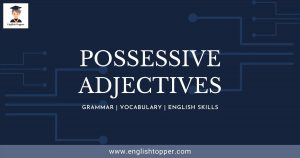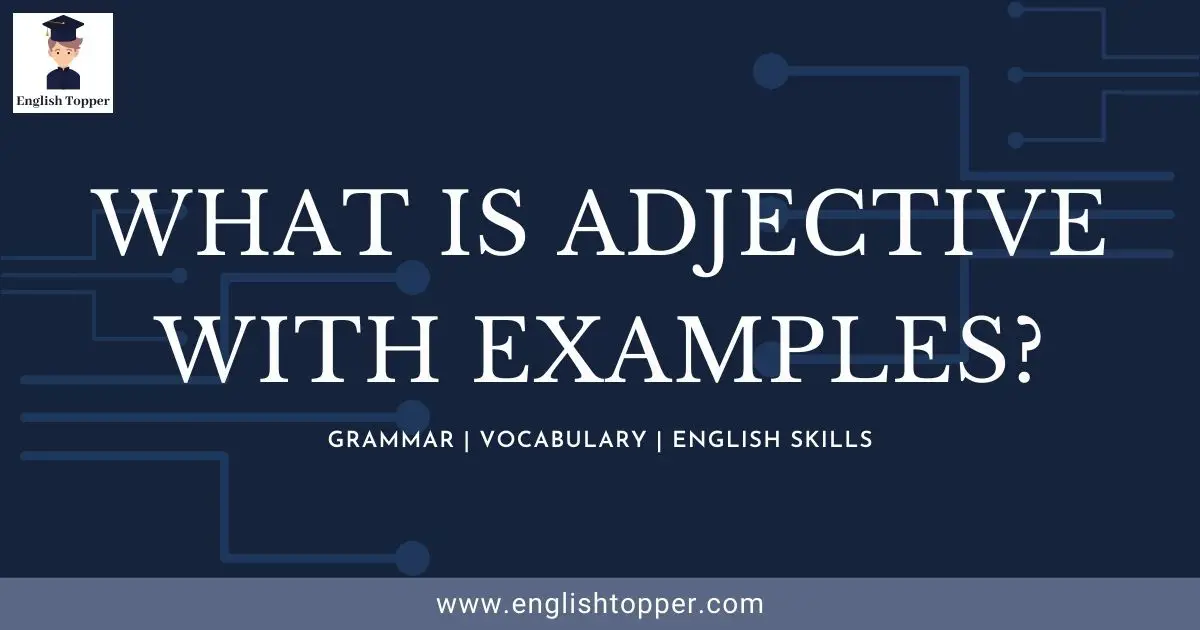|
Getting your Trinity Audio player ready...
|
Table of Contents
What are Possessive Adjectives?
Possessive Adjectives are used for nouns or pronouns to mention the ownership of the people, things, etc. It is one of the types of Adjectives.
In other words, it is used to mention the person or thing who owns something. This type of Adjective is useful when you want to specify something with the owner.
Some of the examples of Possessive Adjectives are shown in the below table.
| Personal Adjective | Possessive Adjective |
| he | his |
| she | her |
| it | its |
| I | my |
| you | your |
| we | our |
| they | their |
| who | whose |
So, overall there are main uses of Possessive Adjective, those are used;
- to show the ownership.
- to show the relationship.
- to mention the parts of the body.
Let us understand this concept with few example sentences.
Also Read: What is Adjective with examples? | Best English Guide 2021
The adjective is a type of word which describes or modifies the noun. It is also defined as, the word which describes the qualities and states of beings of nouns. It measures the qualities like size, shape, colour, duration, behaviour, quantity, etc… (Read More)
Possessive Adjective Examples
Here, PA = Possessive Adjectives.
- Many of them like his behaviour.
Sentence Structure: Many of them (Subject) + like (Verb) + his (PA) + behaviour (Object).
Here, the adjective (his) is used to mention the person who has that behaviour.
- Shilpa often visits her grandma’s house.
Sentence Structure: Shilpa (Subject) + often + visits (Verb) + her (PA) + grandma’s house (Object).
In the sentence, the adjective (her) is used to describe the relationship with that person.
- That dog is wagging its tail.
Sentence Structure: That dog (Subject) + is wagging (Verb) + its (PA) + tail (Object).
Here, the adjective (its) is used to mention the dog’s action.
- This is my house.
Sentence Structure: This (Subject) + is (Verb) + my (PA) + house (Object).
Here, the adjective (my) is used to mention the ownership of the house.
- I like your shoes.
Sentence Structure: I (Subject) + like (Verb)+ your (PA) + shoes (Object).
In the above sentence, the adjective (your) is used to show the ownership of the shoes.
- We should complete our own assignments.
Sentence Structure: We (Subject) + should complete (Verb) + our (PA) + own assignments (Object).
In the sentence, the adjective (our) describes the ownership of the assignments.
- Their kids are very shy.
Sentence Structure: Their (PA) + kids (Subject) + are (Verb) + very shy (Object).
Here, the adjective (their) is used to show the relation with the children.
- May I know whose luggage is this?
Sentence Structure: May + I (Subject) + know (Verb) + whose (PA) + luggage is this? (Object)
In the above sentence, the adjective (whose) is used to represent the ownership of the luggage.
Subject Verb Agreement with Possessive Adjectives
Previously, we had learned about the Subject, Verb and Object which plays an important role in the sentence. Here, in this section, we are going to learn the relationship between the Subject and the Verb.
We have to remember two simple rules which are mentioned below,
- If Subject is singular, then Verb also should be in Singular form.
- If Subject is in Plural, then Verb should also be in Plural form.
- Singular: My book is on the table.
- Plural: My books are on the table.
- Singular: His painting is very popular.
- Plural: His paintings are very popular.
- Singular: Her song is very mesmerizing.
- Plural: Her songs are very mesmerizing.
Generally, we do not add “s” to the adjectives when the noun is plural like in many other languages.
Example Sentences:
- Incorrect: Ours houses are very expensive. (X)
- Correct: Our houses are very expensive. (_/)
Common Mistakes while using Possessive Adjectives
Here are some common mistakes that most people who are beginners do when these adjectives are used in writings.
Mistake 1: Often people write “it’s” instead of “its” in the sentence.
Usually, it’s is the short abbreviation for “it is” but it doesn’t mean that it is a Possessive Adjective. The adjective “its” is Possessive.
- it’s only should be used only when there is a sentence with “it is”.
- its is only used whenever the adjective is used in the sentence.
Mistake 2: Often people also write “you’re” instead of “your” in the sentence.
Here, “you’re” is the short abbreviation for “you are” but it doesn’t mean that it is a Possessive Adjective. The adjective “your” is Possessive.
- you’re only should be used only when there is a sentence with “you are”.
- your should be used only when there is a Possessive Adjective.
Mistake 3: People often gets confused between “there”, “they’re” and “their” and use it without noticing the meaning of the sentence.
Here, “they’re” is the short abbreviation for “they are” but it is not a Possessive Adjective.
- there is used when you want to mention location of something something.
- they’re is used to mention someone (about them).
- their adjective is used to show the possession (ownership).
Mistake 4: Misplacing the word “whose” with “who’s” in the sentence.
Here, “who’s” is the short abbreviation for “who is” but it is not a Possessive Adjective.
- who’s is used in the question type of sentences.
- whose adjective is used for the ownership.
Summary: (What are Possessive Adjectives?)

- Possessive Adjectives are a type of Adjectives used to determine the ownership of the person or thing, etc.
- Some examples of Possessive Adjectives are his, her, its, their, etc.
- It mainly used to describe the ownership, relations and the parts of the body.
- Here, when the adjectives are used, then the agreement between the Subject and Verb in the sentence should be followed.
- People often make mistakes while using few words like who’s and whose, etc which should be avoided when those are used in the sentences.
If you are interested to learn more, then you can refer to Wikipedia here.
I hope that you understood the topic. If you still have any doubts, then comment down below and we will respond as soon as possible.
Liked this article? Please do share this with others. Thank you 🙂





good content:)
Thank you 🙂